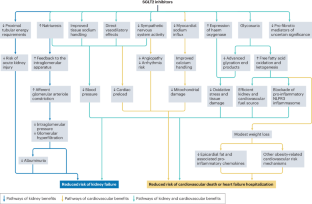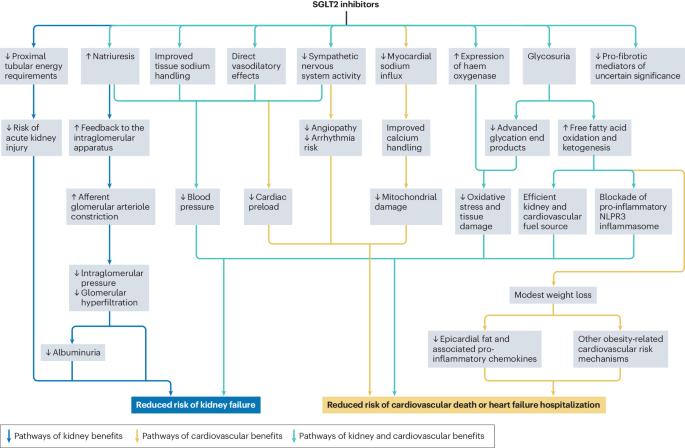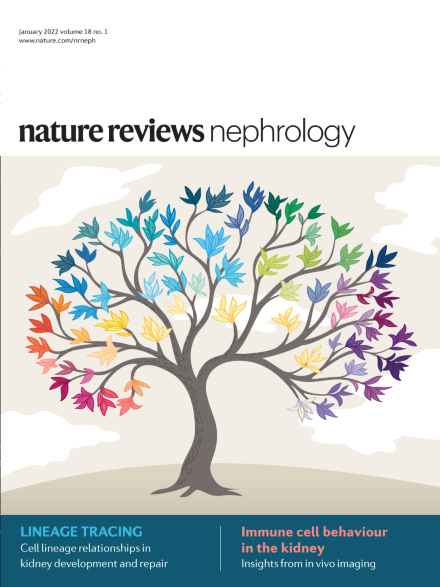SGLT2 抑制剂在控制血糖之外的应用
IF 28.6
1区 医学
Q1 UROLOGY & NEPHROLOGY
引用次数: 0
摘要
钠-葡萄糖共转运体 2(SGLT2)抑制剂最初是因其降糖作用而开发的,在 2 型糖尿病(T2DM)患者中显示出适度的降糖效果。在过去的十年中,这些疗法的一系列大型、稳健的临床试验显示了对各种治疗目标的显著疗效,改变了慢性病治疗的格局。对 T2DM 患者进行的心血管安全性研究表明,SGLT2 抑制剂可降低心血管死亡和心衰住院率。随后在左心室射血分数降低或保留的心力衰竭患者中进行的试验表明,SGLT2 抑制剂对心力衰竭的治疗效果有利。在专门的肾脏结果研究中,SGLT2 抑制剂降低了患有或不患有糖尿病的参与者的肾衰竭发生率。事后分析表明,这类药物对代谢功能障碍相关性脂肪肝、预防肾结石和贫血等多种疾病也有其他益处。SGLT2 抑制剂的不良反应一般较好,但患者的选择和用药咨询仍很重要。我们需要共同努力,更好地将这些药物纳入常规治疗并支持长期坚持用药,以缩小临床试验结果与实际应用结果之间的差距。本文章由计算机程序翻译,如有差异,请以英文原文为准。


Applications of SGLT2 inhibitors beyond glycaemic control
Sodium–glucose cotransporter 2 (SGLT2) inhibitors were initially developed for their glucose-lowering effects and have shown a modest glycaemic benefit in people with type 2 diabetes mellitus (T2DM). In the past decade, a series of large, robust clinical trials of these therapies have demonstrated striking beneficial effects for various care goals, transforming the chronic disease therapeutic landscape. Cardiovascular safety studies in people with T2DM demonstrated that SGLT2 inhibitors reduce cardiovascular death and hospitalization for heart failure. Subsequent trials in participants with heart failure with reduced or preserved left ventricular ejection fraction demonstrated that SGLT2 inhibitors have beneficial effects on heart failure outcomes. In dedicated kidney outcome studies, SGLT2 inhibitors reduced the incidence of kidney failure among participants with or without diabetes. Post hoc analyses have suggested a range of other benefits of these drugs in conditions as diverse as metabolic dysfunction-associated steatotic liver disease, kidney stone prevention and anaemia. SGLT2 inhibitors have a generally favourable adverse effect profile, although patient selection and medication counselling remain important. Concerted efforts are needed to better integrate these agents into routine care and support long-term medication adherence to close the gap between clinical trial outcomes and those achieved in the real world. Here, the authors discuss the beneficial effects of sodium–glucose cotransporter 2 (SGLT2) inhibitors for a range of clinical outcomes beyond glucose lowering, including kidney and cardiovascular protection. They also discuss the need for implementation and adherence initiatives to help translate the benefits of these agents into real-world clinical outcomes.
求助全文
通过发布文献求助,成功后即可免费获取论文全文。
去求助
来源期刊

Nature Reviews Nephrology
医学-泌尿学与肾脏学
CiteScore
39.00
自引率
1.20%
发文量
127
审稿时长
6-12 weeks
期刊介绍:
Nature Reviews Nephrology aims to be the premier source of reviews and commentaries for the scientific communities it serves.
It strives to publish authoritative, accessible articles.
Articles are enhanced with clearly understandable figures, tables, and other display items.
Nature Reviews Nephrology publishes Research Highlights, News & Views, Comments, Reviews, Perspectives, and Consensus Statements.
The content is relevant to nephrologists and basic science researchers.
The broad scope of the journal ensures that the work reaches the widest possible audience.
 求助内容:
求助内容: 应助结果提醒方式:
应助结果提醒方式:


